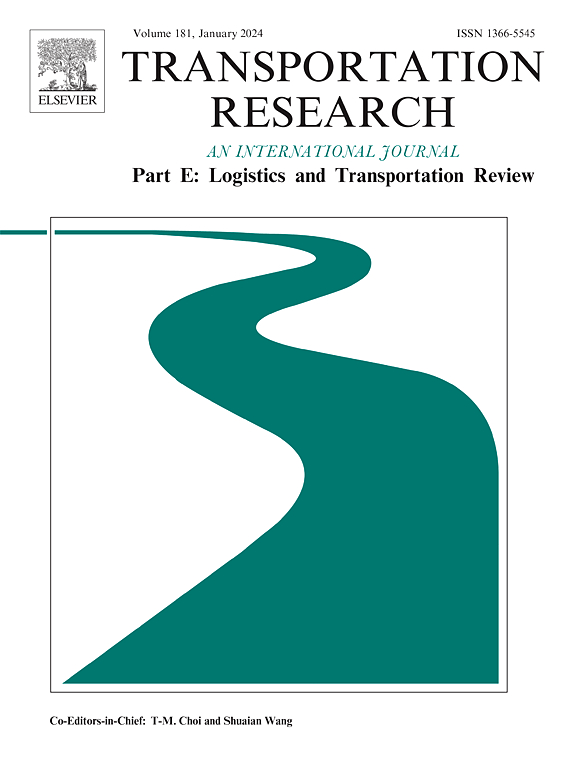Tariff barriers and operational efficiency: the mitigative role of top management team supply chain management experience and potential domestic supply base
IF 8.3
1区 工程技术
Q1 ECONOMICS
Transportation Research Part E-Logistics and Transportation Review
Pub Date : 2025-06-02
DOI:10.1016/j.tre.2025.104204
引用次数: 0
Abstract
Policymakers have portrayed the tariff rate on imports as an enabler for domestic firms to exploit opportunities and improve performance. However, a large tariff increase (LTI) may hinder domestic firms’ access to affordable operational inputs from overseas, potentially reducing their operational efficiency (OE). This study treats 52 LTIs imposed by the United States (U.S.) between 1990 and 2020 as exogenous shocks and employs a quasi-natural experiment to assess their impact on 258 U.S. domestic firms. Specifically, we examine the impact of LTI through the lens of downside risk and upside opportunity, measuring it in terms of the downside loss and upside gain in OE. The results indicate that LTI has adverse effects in both respects: it increases the downside loss and decreases the upside gain of OE. LTI has a more pronounced negative impact on the upside gain than on the downside loss of OE, indicating that it more severely limits domestic firms’ ability to exploit opportunities. We also find that the availability of a potential domestic supply base and the top management team’s supply chain management experience mitigate the negative effects of LTI on both the downside loss and upside gain of OE. This study reveals the holistic effects of LTI on OE and identifies mitigating factors from an operations and supply chain management perspective.
关税壁垒与运营效率:高层管理团队供应链管理经验和潜在国内供应基地的缓解作用
政策制定者将进口关税税率描述为国内企业利用机会和提高业绩的推动因素。然而,大幅提高关税(LTI)可能会阻碍国内企业从海外获得负担得起的运营投入,从而可能降低其运营效率(OE)。本研究将美国在1990年至2020年间实施的52项外国直接投资作为外生冲击,并采用准自然实验来评估其对258家美国国内企业的影响。具体来说,我们通过下行风险和上行机会的视角来考察LTI的影响,并根据OE的下行损失和上行收益来衡量LTI。结果表明,LTI在两个方面都有不利影响:增加了OE的下行损失,降低了OE的上行收益。LTI对OE的上行收益的负面影响比对下行损失的负面影响更明显,这表明它更严重地限制了国内企业利用机会的能力。我们还发现,潜在的国内供应基地的可用性和高层管理团队的供应链管理经验减轻了LTI对OE的下行损失和上行收益的负面影响。本研究揭示了LTI对OE的整体影响,并从运营和供应链管理的角度确定了缓解因素。
本文章由计算机程序翻译,如有差异,请以英文原文为准。
求助全文
约1分钟内获得全文
求助全文
来源期刊
CiteScore
16.20
自引率
16.00%
发文量
285
审稿时长
62 days
期刊介绍:
Transportation Research Part E: Logistics and Transportation Review is a reputable journal that publishes high-quality articles covering a wide range of topics in the field of logistics and transportation research. The journal welcomes submissions on various subjects, including transport economics, transport infrastructure and investment appraisal, evaluation of public policies related to transportation, empirical and analytical studies of logistics management practices and performance, logistics and operations models, and logistics and supply chain management.
Part E aims to provide informative and well-researched articles that contribute to the understanding and advancement of the field. The content of the journal is complementary to other prestigious journals in transportation research, such as Transportation Research Part A: Policy and Practice, Part B: Methodological, Part C: Emerging Technologies, Part D: Transport and Environment, and Part F: Traffic Psychology and Behaviour. Together, these journals form a comprehensive and cohesive reference for current research in transportation science.

 求助内容:
求助内容: 应助结果提醒方式:
应助结果提醒方式:


